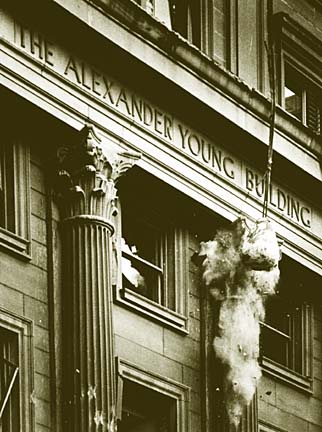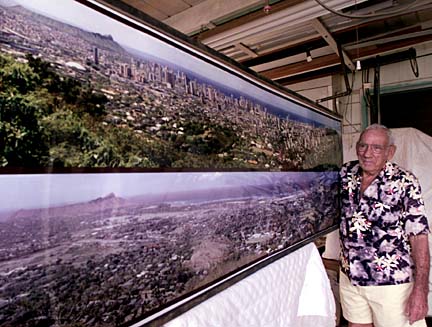


The seeds of change were sprouting in the Honolulu of 1955.
Longtime residents miss the
Landmarks in time
low-rise skyline but enjoy
today's conveniences
About the photos By Craig Gima
Star-BulletinThree high-rise hotels opened in Waikiki: the Princess Kaiulani, the Reef Hotel and the Waikiki Biltmore, which itself became a victim of progress and was imploded to make room for what is now the Hyatt Regency Waikiki. Another hotel -- Henry Kaiser's Hawaiian Village, which was not yet a high-rise -- opened its first 70 rooms.
It was the year Honolulu hosted its biggest convention ever - 3,500 clergy and lay people at the 58th general convention of the Episcopal Church.
That year, 108,000 tourists visited the islands, spending an estimated $56 million.
Today, 177,756 visitors are in the state on an average day. They spend more than $11 billion a year.
In 1955 the Democrats took power for the first time in the Territorial Legislature. A Republican mayor, Neal Blaisdell, fought with the six Democrats on the Board of Supervisors, including a young businessman named Frank Fasi.
At year's end a decision was made that ensured decades of development for Honolulu: The Hawaiian Aeronautics Commission said it would spend $7 million to remodel the Honolulu Airport and put in a 12,000-foot runway that would enable passenger jets to bring more tourists Hawaii.
In August of that year, Air Force Master Sgt. Chester Chaffee took a series of photographs of the view from Diamond Head to Punchbowl.

Forty-five years later, he took another series of photos, then combined each series into a panorama.The two panoramas show more than just a sweeping view. They show how Honolulu evolved from a small town of wooden apartments and single-family homes to a modern high-rise city of apartments, hotels and office buildings.
"We look like a big city now. Yesteryear, we looked like a rural city," said longtime resident Wallace Maruyama as he examined the panoramic pictures with other retired friends over a cup of coffee at McDonald's in Ala Moana Center (which did not exist in 1955).
"The main thing is all the high-rises. After statehood all the high-rises came in," said 70-year-old Fusae Asato.
Asato remembers roller derby at the Honolulu Civic Auditorium (torn down in 1974) and Islanders games at the Honolulu Stadium (torn down in 1976).
In the Honolulu of 1955, people did not lock their doors. There were more local people than tourists in Waikiki. There were farms in Kaimuki and no freeway to take people to what were then sugar and pineapple plantations in Kapolei and Mililani.
"You can go around the island so easily now," said Sandra Yamada, who was 10 in 1955. "When you said you had to go to Kaimuki, it was like going to the country."
"My gosh, we sure have changed," said Tom Dinell, a professor emeritus at the University of Hawaii who founded the School of Urban and Regional Planning.
Dinell remembers when the two major complaints about Waikiki were "no air conditioning and nothing to do after 10 o'clock at night. We've corrected both those problems."
When Dinell came to the University of Hawaii, he said, many of the buildings were converted military barracks, and some faculty lived in Quonset huts. The lower campus, where the Stan Sheriff Center is now, had Klum Gym and a few old military buildings around it and still looked very much like the quarry it once was.
In the old Honolulu you could rent paddle boats on the Ala Wai. The Ward Estate was a gated private residence rather than the area where the Blaisdell Center and shopping centers are today. The Matson cruise ship Lurline docked regularly at Aloha Tower, which was the tallest structure in a low-rise and low-key downtown.
In the 1950s "we didn't really need a downtown," Dinell said. He noted there were 500 lawyers in Hawaii in 1959. There are more than 5,000 today.
"You've got to have a place to put them," he said.
Former city planning and city Department of Land Utilization Director Don Clegg remembers coming to Hawaii in the 1960s.
"This is when we used to say the state bird is the (construction) crane. We won't see that kind of development boom again," he said.
As downtown and Waikiki developed, Clegg said, high-rise apartments sprouted up between them. "People liked to live sort of close to where they worked," he said.
Nancy Bannick, one of the early advocates for historic preservation in Honolulu, said there were some victories and many losses in the battles to save old Honolulu.
"We've built a few good-looking things, but most of the stuff is pretty mediocre compared to the stuff we've lost," she said. She noted the Capitol District with Iolani Palace, Kawaiahao Church and other historic structures was nicely preserved, but much of old Waikiki was lost.
"We've lost our sense of place," Bannick lamented. "Only in a few places have we tried to maintain it."
Bannick said there was not much planning during the '50s and '60s, and individual landowners were looking out for themselves instead of getting together to create coordinated developments.
"When I first came (in 1948), there were no height limits," said Frank Haines, chairman of Architects Hawaii. "You could build a building 100 stories high."
Haines' firm designed the Federal Building, Pacific Tower, Grosvenor Center and Pioneer Plaza. He looked at the panoramic pictures and said the change surprises him. "No one dreamt anything like this would happen," he said.
"(Tourism) is what drove all of it," Clegg says of the development. "If you don't have the economy, jobs, you don't have the need for these other things."
Not all the development was detrimental, Clegg says.
"We could have grown better, but we haven't grown as badly as we might have," he said.
"Honolulu is a much more interesting and vibrant place to live than it was in the 1950s."
>> Diamond Head development:

>> Honolulu Stadium:

>> Ala Moana Center:

>> Honolulu Civic Auditorium:

>> Ward Estate:

>> Aloha Tower:

>> Alexander Young Building:

>> National Cemetery of the Pacific, Punchbowl:


While going through old photographs 10 years ago, Chester Chaffee found a series of photos he had taken from Round Top Drive while showing friends around Oahu in the summer of 1955. Amateur photographer’s
project creates visual
stepping-stones
through timeChester Chaffee captured
By Craig Gima
his first panorama of a changing
Honolulu in summer 1955
Star-Bulletin"I forgot that I had them," he said.
Then Chaffee put the photos side by side. "I said, 'Holy mackerel. That all fits together.'"
Using computer technology, Chaffee had the four separate photos blended together to make a single panorama. He usually goes out each year to take an updated picture of Honolulu.
His last picture was taken in the spring, which is why the city looks so green.
To keep the light and shadows consistent, he took the picture at the same time of day on a date in April, the same number of days back from the summer solstice as the original picture was taken forward from it so the length of the day would be the same.
"The 1955 photos were taken around noon time," he said. "I shoot every 15 minutes to match the shadows on Diamond Head perfectly."
He used an Olympus 35 mm camera with lenses from 20 mm to 200 mm.
"What gets me is the old-timers," Chaffee said. "They point and say, 'I used to live here.' Some of them get a little teary-eyed and walk away 'cause it's not that way anymore."
Chaffee sells the photos on 12-by-36-inch paper at Sears Photo Express and the Art Board in Ala Moana and the Waikiki One Hour Photo in Discovery Bay. He also has other sizes available and can be reached through his e-mail address at ojichet@aloha.net.
Chaffee spent 24 years in the Air Force, serving in World War II, Korea and Vietnam. He was stationed at Hickam Air Force Base from 1953 to 1956, married a local girl, retired here as a master sergeant in 1968 and now lives in Pearl City.
Photography is a hobby for the 82-year-old widower.
He has been taking pictures ever since he got a free Kodak Brownie box camera as a child in West Lafayette, Ind. His home is filled with photos, mostly of scenery like Waimea Canyon and Lumahai Beach.
"It's something you can take with you and bring up memories later on," he says of his hobby.
As for his own memories of 1955, Chaffee remembers going to the Kapiolani Drive-in Theater, watching roller-skating in the Civic Auditorium and stock car racing in the old Honolulu Stadium.
"I look at it and reminisce to myself. The tallest structure in 1955 was Aloha Tower, which was 10 stories high," he said.
As for the changes in Honolulu, "it's progress and you got to accept it. For the original, I stood on the side of the road. Now I've got to use a stepladder and sit on top of it because the koa grew."